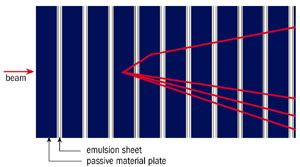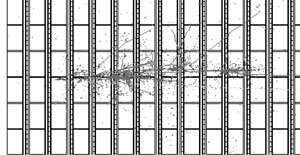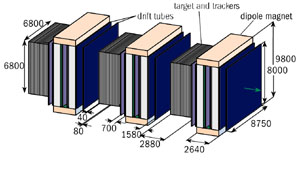
The 2000 tonne OPERA (Oscillation Project with Emulsion Tracking Apparatus) experiment has been approved for construction and operation in the CERN Neutrino Beam to Gran Sasso project. The experiment involves 33 research institutes in 12 countries, including CERN, China and Japan.
The CERN Neutrino Beam to Gran Sasso project, now under construction, will send a beam of high-energy neutrinos from CERN to the Italian underground Gran Sasso laboratory, a distance of 730 km, where the OPERA detector will be assembled. The first neutrinos are expected to be sent in 2005.
Classically, neutrinos come in three varieties – electron, muon and tau, depending on their partner particles. These neutrino varieties are supposed to be immutable, so that a neutrino born alongside a muon should remain a muon neutrino for ever.
However, major experiments monitoring the arrival of neutrinos produced in the atmosphere by cosmic rays provide strong indications that neutrinos are not immutable (see How long until the next supernova?). To explain this observed behaviour, some neutrinos that start off muon-like could transform en route into tau-like neutrinos.
To maximize the chances of seeing such neutrino “oscillations”, the experiment needs a long “baseline”, in this case the 730 km between CERN and the Gran Sasso laboratory. Because of these oscillations, a neutrino beam starting off muon-like as it left CERN would contain tau-neutrinos on arrival at Gran Sasso. When they interact, these tau-neutrinos can produce highly unstable tau leptons, which decay within 1 mm of the neutrino interaction point. Recognizing these tiny decay kinks is the main goal of the OPERA experiment.
To do so it must use a detector with excellent spatial resolution over its whole 2000 tonne mass. The technique chosen is that of the Emulsion Cloud Chamber (ECC), with sheets of passive absorber (lead) material interspersed with emulsion layers to reveal the tracks left by neutrino interactions. The basic OPERA unit is a cell made of a 1 mm thick lead plate followed by a thin film, made of a pair of 50 µm emulsion layers on either side of a 200 µm plastic base (figure 1). Cells will be arranged in turn in removable “bricks”, and the bricks used to build “walls”, modules and supermodules. Downstream of the ECC lattice will be a muon spectrometer.

Each removable brick, weighing 8.3 kg, will have dimensions of 10.2 x 12.7 cm transverse to the beam and 7.5 cm along the beam, and will be made up of 56 individual cells. A wall will be built of 3264 bricks and, with two planes of electronic trackers (plastic scintillator read out by wavelength-shifting fibres), will make up a module. Each target supermodule will consist of 24 modules, and the whole detector, with a cross-section of about 6 x 7 m perpendicular to the beam, will contain three supermodules, representing a total of 235 000 bricks.
The effectiveness of the ECC technique was shown last year through its use in the first observation of explicit tau neutrino signals by the DONUT (Direct Observation of the NU Tau) experiment at Fermilab (see DONUT comes to neutrino town ). DONUT monitored the neutrino outcome after slamming a high-energy proton beam into a compact “beam dump”, thus generating a small number of tau-like neutrinos directly, rather than through oscillations.
Because of its natural divergence, by the time the neutrino beam reaches Gran Sasso it will have spread out across an area of about 800 m. This means that OPERA, mighty as it is, will only see a small slice of the arriving beam.
To build the detector, an assembly line at Gran Sasso will stack lead plates and emulsion films into bricks at the rate of about two per minute. Computer-controlled robots will arrange the bricks in their allocated positions. It will take about a year to fill the detector with bricks.

Emulsion films have a long history in particle physics experiments, one milestone having been the discovery of the pion in 1947 cosmic-ray studies. Automatic emulsion scanning by computerized microscopes was pioneered by the Nagoya group, starting in the late 1970s. Japanese emulsions were used for the CHORUS neutrino experiment at CERN and for DONUT at Fermilab. However, OPERA will need a much greater amount of emulsion than any of its predecessors, and new industrial techniques are being perfected in a collaboration between Nagoya and Fuji Film.
While the experiment is running, the complete detector will be continuously monitored by its own electronic detectors. These electronic trackers, located downstream of each wall, will also be used to identify the brick where a neutrino interaction occurs. These bricks (about 30 per day) will be removed outside the underground hall for calibration. They will then be taken apart and the emulsion plates developed.
Faster scanning procedures than those used for the CHORUS and DONUT experiments will be needed to locate the neutrino interactions. These are now being developed. Further scanning will search for a tell-tale millimetre track followed by a kink, the characteristic fingerprint of a tau decay and therefore of a tau-neutrino interaction.
At the neutrino oscillation rate suggested by experiments to date, OPERA should see about 15 tau-neutrino interactions in five years of running with the nominal performance of the neutrino beam from CERN to Gran Sasso. If so, it will have proved that the disappearance of muon-like neutrinos observed in atmospheric neutrino experiments is indeed due to oscillations into tau-like neutrinos.





